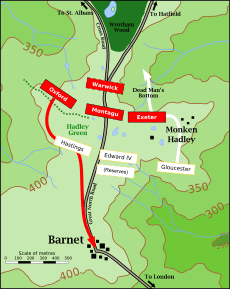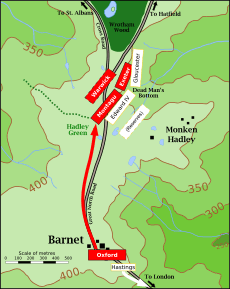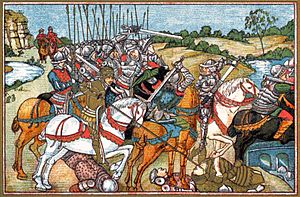Battle of Barnet facts for kids
Quick facts for kids Battle of Barnet |
|||||||
|---|---|---|---|---|---|---|---|
| Part of the Wars of the Roses | |||||||
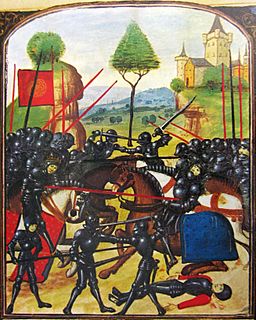 Late 15th-century artistic portrayal of the battle: Edward IV (left), wearing a circlet and mounted on a horse, leads the Yorkist charge and pierces the Earl of Warwick (right) with his lance; in reality, Warwick was not killed by Edward. |
|||||||
|
|||||||
| Belligerents | |||||||
| Commanders and leaders | |||||||
| Strength | |||||||
| 7,000–15,000 | 10,000–30,000 | ||||||
| Casualties and losses | |||||||
| 500 | 1,000 | ||||||
The Battle of Barnet was a very important fight in the Wars of the Roses. This was a long series of battles in 15th-century England. Two powerful families, the House of York and the House of Lancaster, fought to decide who would be king.
On April 14, 1471, near Barnet, King Edward IV led the Yorkist army. They fought against the Lancastrian army, who supported Henry VI. The Lancastrian army was led by Richard Neville, Earl of Warwick. He was so powerful he was called "The Kingmaker."
This battle, along with the later Battle of Tewkesbury, helped Edward IV keep his throne. Historians believe it was a turning point in the Wars of the Roses. Edward's victory led to 14 years of Yorkist rule in England.
Warwick had once been a strong supporter of the Yorkists. But he disagreed with Edward IV about his marriage and other choices. So, Warwick switched sides and joined the Lancastrians. In October 1470, he defeated Edward, forcing the king to flee to Burgundy. Edward then got help from Charles the Bold, the Duke of Burgundy. He raised an army and invaded England. This led to the big battle north of Barnet.
The Yorkists moved close to the Lancastrians in the dark. The battle began in a thick fog at dawn. During the fight, the Earl of Oxford on the Lancastrian side pushed back the Yorkists. But when Oxford's men returned, the Lancastrian center accidentally shot at them. This caused confusion and panic. Many Lancastrian soldiers thought they were being betrayed and ran away. Warwick was killed by Yorkist soldiers while trying to retreat.
Warwick was a very powerful person in England. After he died, no one else had as much power or popularity. Without Warwick's help, the Lancastrians lost again at the Battle of Tewkesbury. This ended Henry VI's rule and brought the House of York back to power. Many years later, a stone monument was built where Warwick was thought to have died.
Contents
Why the Battle Happened
The Wars of the Roses were fights between English noble families. They supported either the House of York or the House of Lancaster. Both families were related to King Edward III. In 1461, the Yorkists, led by Edward IV, took the throne. They removed the Lancastrian king, Henry VI. Henry was captured in 1465 and put in the Tower of London.
Henry's wife, Margaret of Anjou, and their son, Edward of Lancaster, went to Scotland. They tried to fight back. Edward IV stopped these uprisings. He also made the Scottish government force Margaret to leave. The Lancastrian family then went to live in France.
As the Yorkists gained control, Edward rewarded his supporters. His main advisor was Richard Neville, 16th Earl of Warwick. Edward gave him higher titles and land. But Warwick later became unhappy with the king's decisions. Their friendship became difficult.
Warwick's Disagreements with Edward IV
Warwick wanted Edward to marry a French princess, Bona of Savoy. This would have created an alliance with France. But Edward wanted to be friends with Burgundy instead. In 1464, Edward secretly married Elizabeth Woodville. She was a poor Lancastrian widow. Many Yorkists thought she was not a good choice for a queen.
Edward gave land and titles to Elizabeth's family. He also arranged for them to marry rich and powerful families. This limited the marriage choices for Warwick's own daughters. Warwick was also upset by two specific marriages. His aunt, Lady Katherine Neville, who was over 60, married Elizabeth's 20-year-old brother. Also, his nephew's fiancée was taken by the Queen's son, Thomas Grey.
Warwick felt that the Woodville family had too much influence on the king. He felt less important and decided to act. He planned to replace Edward with Edward's younger brother, Duke of Clarence. Clarence was also part of this plan.
Warwick's Rebellions
Warwick started several rebellions in the north of England. This drew King Edward away from his main supporters in the south. Edward found himself outnumbered. He learned that Warwick and Clarence were openly supporting the rebellion. After winning the Battle of Edgecote Moor in July 1469, Warwick captured Edward. He took the king to Warwick Castle for "protection."
Lancastrian supporters used Edward's capture to start their own uprisings. But most Yorkist lords did not support Warwick. So, Warwick had to release the king. Edward did not punish Warwick right away. But Warwick suspected the king was still angry.
Warwick then planned another rebellion to replace Edward with Clarence. But Edward crushed this uprising at the Battle of Losecoat Field in March 1470. Warwick and Clarence had to flee to France. King Louis XI helped Warwick make a deal with Queen Margaret. Warwick agreed to support the Lancastrian cause.
Warwick invaded England with a Lancastrian army. In October 1470, he forced Edward to seek safety in Burgundy. Henry VI was made king again for a short time. But on March 14, 1471, Edward brought an army back to England. This led to the Battle of Barnet a month later.
Leaders of the Armies
Yorkist Leaders
Edward IV usually fought at the front of his armies. He was very tall, about 6 feet 3 inches. He wore shining armor and was an inspiring leader in battle. People described him as handsome and strong. He was also friendly and charming, which helped him gain supporters.
Edward was a good planner and leader in battles. He often found weak spots in enemy lines and used them to win. By 1471, he was a respected military commander. Some people criticized him for not always acting quickly to stop rebellions. But historians praise his leadership and fighting skills. Edward was popular with common people, especially compared to Henry VI. His trade policies helped English businesses.
Edward was joined at Barnet by his brothers, Richard, Duke of Gloucester, and George, Duke of Clarence. Gloucester was 18 years old at Barnet. This was his first big battle. Many historians say he was a skilled fighter and leader.
Clarence was not as trusted as his brothers, especially when it came to loyalty. When Edward became king, Clarence was his heir. But then Edward had children, Elizabeth of York and Edward V. This meant Clarence was no longer next in line for the throne. So, Clarence joined Warwick's plans. He married Warwick's daughter, Isabella. He hoped to take his brother's throne.
Clarence lost faith in Warwick when Warwick joined the Lancastrians. Warwick married his other daughter, Anne, to the Lancastrian prince. When Edward came back to England, Clarence accepted his brother's offer of forgiveness. He rejoined the Yorkists on April 2, 1471.
The last Yorkist commander was William, Lord Hastings. He was loyal to Edward from the start of the wars. Hastings went with Edward when he was in exile. He supported Edward's return to England. Edward rewarded him with important positions.
Lancastrian Leaders
Warwick had fought for the House of York for many years. He fought alongside his cousin, Edward IV, in many battles. His loyalty and victories made him a very important person. He was popular with common people. He had a lot of power over who would be king, earning him the name "The Kingmaker."
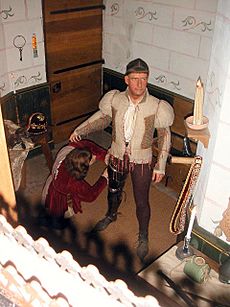
Early historians thought Warwick was a military genius. But later historians questioned this. Some think he was just lucky in some battles. Others believe he was too defensive and not flexible enough in his plans.
John Neville, 1st Marquess of Montagu, was Warwick's brother. He was less ambitious but a better fighter and planner. In 1464, he led a Yorkist force that defeated a Lancastrian ambush. He also launched a surprise attack at the Battle of Hexham. Edward rewarded him with the Earldom of Northumberland. This was a rich area. Neville's family had a long-standing rivalry with the Percys, who were the former earls of Northumberland.
However, in March 1470, Edward gave the earldom back to Henry Percy. Edward did this to gain the Percys' support. Neville received a grander title, Marquess of Montagu. But the lands that came with this title were much poorer. Montagu felt insulted. He thought it was not enough for his years of loyal service. He did not join Warwick's rebellion right away. He switched sides later when his brother invaded England.
Not much is known about the early life of John de Vere, 13th Earl of Oxford. He was another Lancastrian commander. His father, the previous earl, was executed for trying to kill Edward IV. Edward tried to win Oxford's loyalty by making him a knight. But Oxford remained loyal to the Lancastrian cause. He helped Warwick try to remove Edward from the throne. Historians say Oxford was a good military leader, as shown at Barnet.
Henry Holland, 3rd Duke of Exeter, was related to the royal family. But he was often seen as a violent and foolish person. He disliked the Neville family, especially Warwick. Warwick had taken his role as Lord High Admiral. But when Warwick joined the Lancastrians, Exeter obeyed Queen Margaret. He served under Warwick during the invasion of England. Exeter was married to Anne of York, Edward's sister.
Getting Ready for Battle
On March 14, 1471, Edward's army landed at Ravenspurn. They gathered more men as they moved towards York. At first, Edward faced no opposition. He was moving through lands belonging to the Percys. The Earl of Northumberland owed Edward for getting his northern lands back. Edward also said he was only returning to claim his father's title, Duke of York. He said he was not trying to take the English crown.
This trick worked. Montagu was watching Edward's march. But he could not convince his men to fight Edward. Once Edward's army was strong enough, he stopped his trick. He headed south towards London. He fought off attacks from Exeter and Oxford. He then surrounded Warwick at Coventry, hoping to fight him.
Warwick's army was larger than Edward's. But Warwick refused to fight. He was waiting for Clarence to arrive. They wanted to combine their armies to defeat the Yorkists. When Edward learned this, he sent Gloucester to ask Clarence to return to the Yorkist side. Clarence quickly agreed.
The royal brothers then moved towards Coventry. Clarence urged Warwick to surrender. Warwick was furious with his son-in-law's betrayal. He refused to speak to Clarence. Since Edward could not fight Warwick there, he turned towards London.
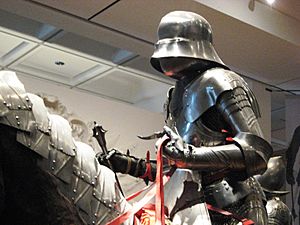
A few days later, Warwick, reinforced by Montagu, Oxford, and Exeter, followed the Yorkists. He hoped London, which was controlled by Somerset, would close its gates to Edward. This would trap Edward's army in the open. But the city welcomed Edward warmly. Somerset had left, and the people of London preferred the young Yorkist king to Henry VI. The old king Henry greeted Edward warmly. He offered himself into custody, trusting Edward.
Lancastrian scouts explored Barnet, which was about 12 miles north of London. But they were driven back. On April 13, the main Lancastrian army took positions on a ridge north of Barnet. They prepared for battle the next day. Warwick arranged his army in a line from east to west. It was on both sides of the Great North Road. Oxford held the right side, and Exeter held the left. Montagu commanded the center. Warwick planned to command from the reserves. He moved his line slightly to the west. A dip behind his left side could cause problems for Exeter's group if they had to fall back.
Warwick's army was much larger than Edward's. Sources say the Lancastrians had 10,000–30,000 men. The Yorkists had 7,000–15,000. Edward decided to attack the Lancastrians by surprise. He brought Henry VI with him. This was to prevent the Lancastrians from getting their king back.
Edward reached Barnet in the evening. He did not know exactly where his enemies were. But he prepared his battle line. He placed Hastings on the left and Gloucester on the right. Clarence would fight with Edward in the center. This was partly to keep an eye on Clarence, who had switched sides twice. A group of reserves was kept at the back.
As night fell, Edward began his plan for a surprise morning attack. The Yorkist army moved closer to the Lancastrians in silence. During the night, neither army saw the other. This was very important for the battle the next day.
During the night, Warwick ordered his cannons to fire at where he thought the Yorkists were camped. But the Yorkists had moved much closer. So, the Lancastrian cannon shots went over their heads. The Yorkist cannons stayed quiet to hide their location. As the armies rested, Montagu told his brother Warwick that the troops' morale was low. He suggested that they, as the top commanders, should fight on foot. This would show the soldiers they were ready to fight to the death. Warwick agreed, and the horses were tied up at the back.
Fighting in the Mist
On April 14, 1471, around 4 AM, both armies woke up. Edward had planned an early attack. He quickly got his men ready to fight the Lancastrians. Both sides fired cannons and arrows. Then they fought hand-to-hand with long weapons.
The morning fog was very thick. The armies had moved in the night. So, they were not facing each other directly. Each army was slightly to the right of the other. This meant the right side of one army could go around the left side of the other. The Lancastrians were the first to use this. Oxford's group quickly defeated Hastings' Yorkist group.
Yorkist soldiers ran towards Barnet, chased by the Lancastrians. Some of Hastings' men even reached London. They spread news that the Yorkists had lost and the Lancastrians had won. Oxford's group broke apart as they stopped to loot the dead and Barnet. Oxford yelled and chased after his men. He managed to gather 800 of them and led them back to the battle.
Because of the fog, it was hard to see. The two main armies did not notice Oxford's victory over Hastings. So, the defeat of the Yorkist left side did not affect the morale of either side much. The fighting between Montagu's and Edward's groups was very intense and even.
However, the Lancastrian left side was having trouble. Gloucester used the misaligned forces to his advantage. He pushed Exeter's group back. Gloucester's progress was slow because his group was fighting uphill. But the pressure he put on the Lancastrian left side made the whole battle line turn. Warwick saw this change. He sent most of his reserves to help Exeter. He took the rest to fight in the center. Slowly, the battle line became slanted from northeast to southwest.
Oxford returned through the fog to the fight. His group arrived, unexpectedly, behind Montagu's men. The fog made it hard to see. Montagu's men mistook Oxford's "star with rays" badge for Edward's "sun in splendour" badge. They thought their allies were Edward's reserves and fired arrows at them.
Oxford and his men immediately shouted "treachery!" As strong Lancastrians, they were suspicious of Montagu, who had recently switched sides. They fought back and started to leave the battle. Their shouts of treason spread quickly through the Lancastrian line. The line broke apart as men ran away in anger, panic, and confusion.
As the fog began to clear, Edward saw the Lancastrian center in chaos. He sent in his reserves, which made the collapse happen faster. Shouts that Exeter had died from a Yorkist axe spread from the Lancastrian left. In the confusion, Montagu was hit in the back and killed. It was either by a Yorkist or one of Oxford's men.
Warwick saw his brother die. He knew the battle was lost. He tried to reach the horses to retreat. Edward saw his victory was near. He decided Warwick was more valuable alive than dead. He sent his guards to capture the earl alive. Some historians think Edward wanted to capture Warwick for a public execution. Regardless of Edward's plan, Warwick died during the Lancastrian retreat. A small model of the Battle of Barnet can be seen at The Barnet Museum.
After the Battle
The battle lasted about two to three hours. It was over by the time the fog lifted in the early morning. As in most battles of that time, the army that ran away suffered more deaths. Fleeing men were often cut down from behind.
Different records give different numbers of deaths. One record says 1,500 people died. Another says 4,000. Some 16th-century writers say at least 10,000 men died. The Yorkists had about half as many deaths as the Lancastrians. Historians generally agree on about 500 Yorkists and 1,000 Lancastrians killed.
The bodies of the two Neville brothers, Warwick and Montagu, were taken to London. They were buried in their family tomb at Bisham Abbey.
Even though he had defeated the Neville brothers, Edward had little time to rest. Queen Margaret landed in Weymouth on the same day as the battle. She pretended to march to London. But she was actually gathering more soldiers from Wales. The news of Warwick's death upset her. But Somerset suggested they were better off without him. Lancastrians who fled Barnet looked to the queen to restore their family to the throne.
Edward's spies told him about the Lancastrians' real route. Edward stopped them and defeated them at the Battle of Tewkesbury on May 4. Gloucester, Clarence, and Hastings again fought to protect the Yorkist crown.
Exeter was found alive but badly hurt on the Barnet battlefield. His followers took him to Westminster Abbey. After he recovered, he was imprisoned in the Tower of London for four years. He then agreed to obey Edward. Exeter did not fight in later battles of the Wars of the Roses. Edward sent him on a trip to France in 1475. Exeter was reported to have fallen overboard and drowned.
After leaving the battle, Oxford fled to France. He attacked English ships, continuing his fight against Yorkist rule. He was captured in 1473 after taking St Michael's Mount, an island off England's southwest coast. Twelve years later, Oxford escaped from prison. He joined Henry Tudor's fight against the Yorkists. He commanded the Lancastrian army at the Battle of Bosworth Field in 1485.
What We Learn from Barnet
The Battle of Barnet was a very important event in the Wars of the Roses. It led to the death of a major figure and secured the throne for Edward IV. Even though it was so important, there are not many detailed records about the battle from that time.
The only account from someone who saw the battle is The Arrivall of Edward IV. This was written by someone in Edward's council, so it might be biased. Another first-hand account is in the Paston Letters, written by a Lancastrian supporter. Other records, like The Warkworth Chronicle, only give small pieces of information. So, historians have to use field research and other old documents to understand the battle.
Historians think that if Warwick's army had joined Margaret's before fighting Edward, the combined Lancastrian army would have been too strong for the Yorkists. Instead, Warwick's defeat gave the Yorkists a huge victory. This, along with the Battle of Tewkesbury, secured the English throne for Edward IV. Some historians believe Edward's return to power was certain after Barnet. Tewkesbury was just the final step.
Without Warwick's popularity and political power, Edward could rule England without challenge. Songs from Edward's time celebrated his victory as being blessed by God. The Battle of Barnet was a disaster for the Neville family. They lost their lands and power. The family never again had the same importance in English politics as they did before the battle.
Barnet in Shakespeare's Plays
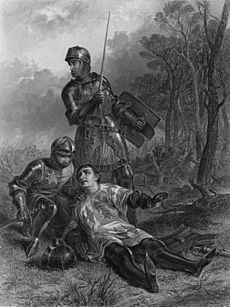
The Battle of Barnet is mentioned in William Shakespeare's play Henry VI, Part 3 (1595). The end of Act V, scene one, shows what happened before the battle. Scenes two and three show the end of the battle. Characters talk about the fight and what happened to those involved.
Shakespeare uses few details from the old records. He leaves out important parts, like the confusion over the badges. His play is more about poetry and drama. In the play, Montagu is killed trying to save his brother. Warwick is dragged in by Edward IV and speaks his dying words to Oxford and Somerset. Warwick's death is a big part of these scenes. This shows how important his death was.
Shakespeare shows the Neville brothers as willing to die for each other. But the three Yorkist brothers—Edward, Gloucester, and Clarence—are slowly pulled apart by their own goals. One professor suggests that Shakespeare did not agree that Edward's victory was from God. He argues that Shakespeare shows Edward's rule came from his military strength, luck, and clever plans. Shakespeare also does not show Edward in the fighting parts of the play.
The Battlefield Today
English Heritage, a group that protects historic sites, says the battlefield is about 0.5 to 1.0 mile north of Barnet town. Over the years, the land has changed a lot. Records of the town's old borders are not detailed enough. So, English Heritage and historians cannot say exactly where the battle took place.
English Heritage suggests that a 15th-century letter from a merchant helps find the battlefield. It mentions a "broad green," which might be Hadley Green. The marsh on the right side of the Yorkist line is likely in the valley of the Monken Mead Brook. The letter also mentions St Albans road, which is still mostly the same.
Over the 18th and 19th centuries, many buildings were built in the area. By the 20th century, the town of Monken Hadley covered part of the battlefield. A hedge in the local golf course might be where Oxford's men hid, as suggested by Lieutenant-Colonel Alfred H. Burne.
In 1740, Sir Jeremy Sambroke built a stone monument to remember the battle. It was first about 200 meters south of a road junction. Later, it was moved just north of the junction. It is called Hadley Highstone. It is about 5.5 meters tall. It has an inscription that says:
"Here was fought the Famous Battle Between Edward the 4th and the Earl of Warwick April the 14th ANNO 1471 in which the Earl was Defeated And Slain."
The battle is also shown on the coat of arms of the London Borough of Barnet. It has a red and a silver rose at the top of the shield. It also has two crossed swords in the crest.
See also
 In Spanish: Batalla de Barnet para niños
In Spanish: Batalla de Barnet para niños


